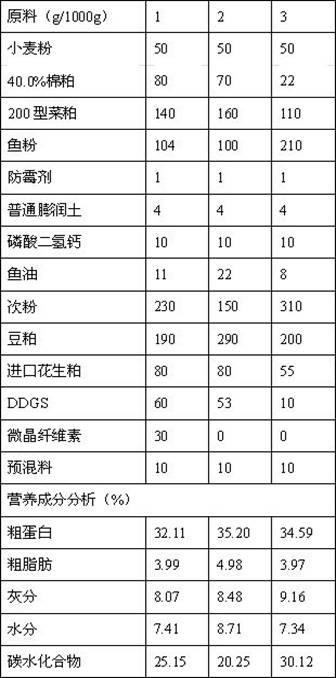Triangular bream compound feed
A technology for compound feed and triangular bream, applied in animal feed, animal feed, application and other directions, can solve the problems of bait coefficient resource waste, environmental pollution, etc., and achieve the effects of improving feed utilization, reducing environmental pollution, and improving survival rate.
- Summary
- Abstract
- Description
- Claims
- Application Information
AI Technical Summary
Problems solved by technology
Method used
Image
Examples
Embodiment 1
[0017] Example 1: Formula 1 as shown in Table 1 is used to prepare feed (crude protein 32%, crude fat 4%, carbohydrate 25%, ash 8%, moisture 7.5%), and feed about 12.8 g of triangle bream for 60 days. After the experiment, the average weight of this group of triangle bream was about 45.5g, the weight gain rate was 255.05%, the specific growth rate was 2.09, the protein efficiency was 2.07, and the feed coefficient was 1.58. All parameters were consistent with those of the commercial feed group (28% crude protein, 10 crude fiber). %, ash content 18%, moisture content 12%) compared with significantly improved.
Embodiment 2
[0018] Example 2: Formula 2 shown in Table 1 is used to prepare feed (crude protein 35%, crude fat 5%, carbohydrate 20%, ash 8.5%, moisture 8.8%), and feed about 12.8 g of triangle bream for 60 days. After the experiment, the average weight of this group of triangle bream was about 43.8g, the weight gain rate was 243.23%, the specific growth rate was 2.04, the protein efficiency was 1.80, and the feed coefficient was 1.65. All parameters were the same as those of the commercial feed group (crude protein 28%, crude fiber 10 %, ash content 18%, moisture content 12%) compared with significantly improved.
Embodiment 3
[0019] Example 3: Formula 3 shown in Table 1 was used to prepare feed (crude protein 35%, crude fat 4%, carbohydrate 30%, ash 9%, moisture 7.4%), and feed about 12.8 g of triangle bream for 60 days. After the experiment, the average weight of this group of triangle bream was about 41.6g, the weight gain rate was 224.65%, the specific growth rate was 1.94, the protein efficiency was 1.67, and the feed coefficient was 1.79. All parameters were the same as those of the commercial feed group (28% crude protein, 10 crude fiber). %, ash content 18%, moisture content 12%) compared with significantly improved.
[0020] 1. Specific growth rate (%d-1)=100×(ln final body weight-ln initial body weight) / number of experimental days
[0021] 2. Weight gain rate (%) = (final average weight-initial average weight) × 100 / initial average weight
[0022] 3. Feed coefficient = feed amount / (final weight-initial weight)
[0023] 4. Protein efficiency = (final weight-initial weight) / protein dosage
[0024] T...
PUM
 Login to View More
Login to View More Abstract
Description
Claims
Application Information
 Login to View More
Login to View More - R&D
- Intellectual Property
- Life Sciences
- Materials
- Tech Scout
- Unparalleled Data Quality
- Higher Quality Content
- 60% Fewer Hallucinations
Browse by: Latest US Patents, China's latest patents, Technical Efficacy Thesaurus, Application Domain, Technology Topic, Popular Technical Reports.
© 2025 PatSnap. All rights reserved.Legal|Privacy policy|Modern Slavery Act Transparency Statement|Sitemap|About US| Contact US: help@patsnap.com

